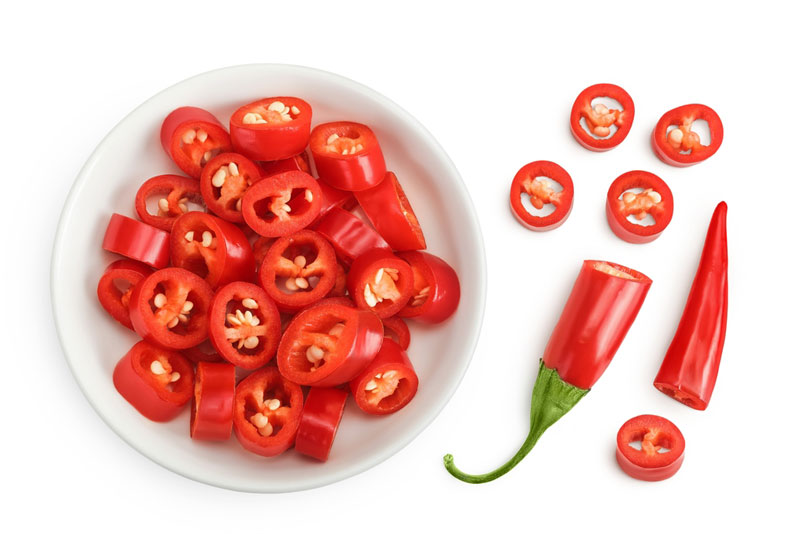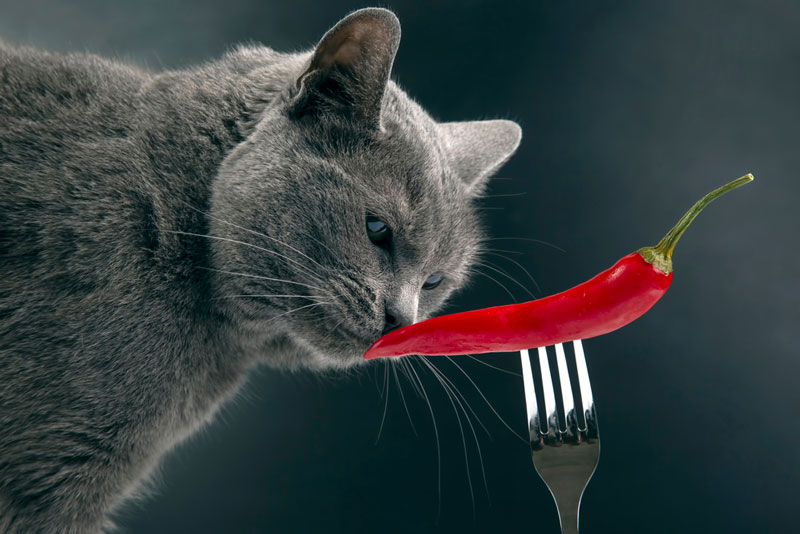Have you ever wondered if your feline friend can join you for a spicy snack? Well, let’s answer that pressing question: can cats eat chili? The short answer is a resounding no! Chili peppers contain compounds that can be harmful to our pets, and cats have very different digestive systems than we do.
Cats are obligate carnivores, meaning they thrive on a diet high in animal protein and do not require plant-based foods. This means that spicy foods like chili do not belong in their diets. A little taste is one thing, but it’s best to keep these fiery ingredients away from your curious kitty.
If you’re eager to learn more about why chili is a no-go for your cat, the potential dangers it carries, and what you should feed your furry friend instead, keep on reading! We’ve got a wealth of information just waiting for you to discover it.
Can Cats Eat Chili?

When it comes to chili peppers, we can’t help but feel that they belong on our plates and not in our cats’ bowls. Cats have taste buds that are remarkably different from ours. They cannot taste sweetness, and their digestive systems aren’t designed to handle spicy foods like chili. These spicy peppers contain capsaicin, which is what makes them hot and zesty. While we might enjoy a kick of heat in our meals, for cats, capsaicin can lead to numerous discomforts.
Chili peppers can irritate a cat’s digestive system, especially if consumed in larger quantities. Symptoms such as vomiting and diarrhea are common reactions. It’s important to remember that cats are not built to process spices like we are. Because they are natural hunters, their stomachs are optimized for meat digestion, not for spicy plants.
Also, we should be aware that some cats are more sensitive than others. Even a tiny amount could potentially cause them distress. If you’ve ever seen your cat’s expression after tasting a mint leaf or a bit of lemon, you might grasp that their reactions can be quite colorful!
At the end of the day, even though it might seem funny to imagine your cat trying to deal with chili, it’s a risk we should steer clear of. Feeding chili or any spicy food to our adorable little furballs is asking for trouble.
How Much Chili Can Cats Eat?
In short, the answer to “how much chili can cats eat?” is none! That’s right, zero amount is the ideal quantity. Even just a tiny spoonful can potentially lead to an upset stomach or more severe issues. Every cat is different, meaning their reactions might vary. Some might handle a minuscule taste without apparent consequences, while others might succumb to distress just by sniffing it.
The important thing to realize here is that a cat’s body is not equipped to process spicy foods. Capsaicin, the active compound that gives chili its signature heat, can induce irritation in a cat’s mouth, throat, and overall digestive tract. This irritation manifests as excessive drooling, pawing at their mouths, or refusing to eat altogether.
If you think for one moment that just because your neighbor’s cat seems fine after sneaking a lick of chili sauce, yours will be too, think again! You might be taking a very risky gamble. As pet owners, we need to protect our furry buddies and give them a diet that suits their needs rather than our cravings.
Plus, when it comes to feeding our pets, moderation is often key with many foods, but with spicy items like chili, moderation does not apply. We just need to avoid them completely and provide those little darlings with balanced meals made for their stomachs. Hopefully, by shunning spicy foods like chili and taking proper care of our pets, we can help them lead a happy, healthy life.
Benefits Of Chili To Cats
1. A soft and balanced diet is crucial for our cats since protein-rich foods can greatly benefit their health.
One of the inevitable perks of cutting out chili and spicy foods from our cats’ diets is that we ensure they get what they truly need: high-quality protein! Cats need a healthy diet consisting mainly of meats like chicken, fish, and beef, catering specifically to their unique digestive systems. This will help maintain their energy levels and overall health, making for a happier furry friend.
2. Instead of feeding chili, we can offer our cats meat-based treats, which are tasty, nutritious, and completely safe!
Since chili is off the table, we can replace it with a plethora of other safe foods. There are numerous options for cat treats, such as freeze-dried meat, chicken-flavored biscuits, or even a bit of tuna (in moderation). Each of these choices brings excitement to snack time, allowing our furry companions to enjoy their meals without any unpleasant side effects.
3. Keeping spicy foods away from our cats prolongs their well-being and prevents illness.
Avoiding chili means protecting our priceless pets from issues that could harm their health. From indigestion to more serious complications, steering clear of spicy foods is a key duty of responsible pet ownership. By preventing such ailments, we contribute to longer, happier lives for our cats.
4. Our focus on nutritious food establishes positive bonding moments with our feline companions.
Choosing healthy meals supports our cats’ love for us—it’s often said that the way to a pet’s heart is through their stomach! When we prioritize quality nutrition, we create opportunities for bonding over fun mealtime moments, making our relationship stronger as we discover and enjoy new treats together.
5. Removing chili from our cats’ diets inspires us to learn even more about pet-friendly nutrition.
By understanding what our cats can and cannot eat, we take the initiative to explore their unique dietary needs. This journey of knowledge can inspire us to better appreciate the fabulous world of feline nutrition. We may even get excited about discovering new and healthy recipes specifically designed for our whiskered pals! The more we educate ourselves, the better we can care for our beloved pets.
Dangers Of Feeding Chili To Cats
Even if we’re tempted to include a little chili in our cats’ diets as a joke, we have to consider the dangers. A feline’s digestive system is quite sensitive, and many cats can exhibit adverse reactions to chili. For example, capsaicin can lead to gastrointestinal issues, including vomiting and diarrhea. In short, when our precious pets eat something spicy, we run the risk of sending them directly to the vet.
Another risk is that the heat of the chili can irritate their mouths and throats. The last thing we want is for our cats to suffer from pain, discomfort, or stress because of something as silly as a little spicy flavor. Imagine watching your cat paw at their mouth and meow sorrowfully! We’ll feel terrible, and the last thing you want is to place your cats through any unnecessary anguish.
Over time, chronic consumption of capsicum-containing foods can lead to more severe complications, such as gastritis or pancreatitis. As loving pet owners, it’s up to us to be vigilant about what we feed our pets to keep them healthy and shiny.
This translates into understanding the consequences of offerings chili—even a tiny taste—could bring our furballs. Instead of risking their health by playing with fire, let’s stick to cat-approved treats and delicious meals made just for them. Remember, a healthy cat is a happy cat, and we want those blissful purrs, right?
Substitute Of Chili For Cats
1. Chicken Or Turkey: Our cats often find these proteins irresistible. A tiny portion of cooked, unseasoned lean chicken or turkey can become their new favorite treat, and it’s much safer than chili!
2. Fish: Cats enjoy seafood, so a little bit of canned tuna or salmon (in water, no added salt) can be a delightful substitute. Just remember to moderate portions, as these should be occasional treats and not daily meals.
3. Baby food: Unsalted baby food made primarily from meat can be a hit! It’s simple and often comes in flavors that cats adore. Just be sure there are no onions or garlic present in the ingredients, as those can be hazardous to our pets.
4. Cat Treats: There are countless varieties of store-bought cat treats available that cater to their tastes. Many of these are healthier than human foods, depending on the brand. Indulging your cats with commercially available snacks designed for them is a wise move!
5. Freeze-dried Food: This convenient option can serve as a special treat for our furry friends. Freeze-dried meat retains nutrients and flavor while providing a safe alternative to chili. Cats love these tender morsels!
Can Cats Eat Chili? Frequently Asked Questions
Is It Safe For My Cat To Smell Chili?
While a smell is not as harmful as consumption, it may still cause irritation. If you find your cat curiously sniffing around, make sure they don’t get too close.
What Are The Signs My Cat Might Have Eaten Chili?
If your cat has consumed chili, watch for symptoms such as vomiting, diarrhea, drooling, or signs of distress. If you notice any of these symptoms, a vet visit is likely warranted.
Can Cats Have Spicy Snacks Like Salsa?
It’s best to steer clear of spicy snacks for cats, as the same risks apply. Stick to safe, healthy treats designed for their dietary needs.
What If My Cat Accidentally Eats Something Spicy?
Monitor them closely for signs of distress. If they seem to be struggling or exhibiting severe symptoms, contact your veterinarian for assistance.
How Can I Ensure My Cat Has A Healthy Diet?
Incorporate high-quality pet foods, along with safe treats that are designed for cats. Focus on proteins and consult your vet for dietary advice as needed.
Final Thoughts
Keeping chili and spicy foods away from our furry companions is crucial for their well-being. We all want to see our cats happy and healthy, with no trips to the vet for spicy misadventures! Instead of risking their health, let’s embrace their natural diet and preferences by focusing on things they can safely munch.
By prioritizing their safety, we cultivate a strong bond and create a friendly environment. Many delightful alternatives are available for snacking. Try exploring yummy meat-based options, or discover healthy recipes made specifically for our fabulous feline friends. When it comes to caring for our pets, love and responsibility go hand in hand.
If you’re curious about what else you can feed your pets, take a peek at some other related topics. Check out our blog for more fun information, or read about whether Can Cats Eat Ramen Noodles? or Salad?. The adventure to finding the best for our pets is never-ending, and together, we can make informed choices that lead to happier, healthier cats!


